Rajasthan Board RBSE Class 11 Economics Chapter 9 Median
RBSE Class 11 Economics Chapter 9 Text book Questions
RBSE Class 11 Economics Chapter 9 Multiple Choice Questions
Question 1.
For those facts that cannot be expressed in numbers, the best mean is:
(a) Arithmetic Mean
(b) Median
(c) Mode
(d) Harmonic Mean
Answer:
(b) Median
Question 2.
The median of the following series is: 8, 11, 12, 13, 15, 18
(a) 12.5
(b) 13
(c) 12
(d) 14
Answer:
(a) 12.5
Question 3.
The value dividing a series in four equal parts is called:
(a) Average
(b) Median
(c) Quartile
(d) Pentant
Answer:
(c) Quartile
![]()
Question 4.
The second quadrant of a series is called:
(a) Lower quadrant
(b) Higher quadrant
(c) Mean
(d) Median
Answer:
(d) Median
Question 5.
If the mode is 18 and arithmetic mean is 20, then the median will be:
(a) 29.33
(b) 19.33
(c) 18.66
(d) 9.33
Answer:
(b) 19.33
RBSE Class 11 Economics Chapter 9 Very Short Answer Type Questions
Question 1.
What do you understand by median?
Answer:
Median is that variable value of a data-item series which divides the ordered series into two equal parts in such a way that all the values in one part are greater than the median and all the value of the other part are lesser the median value.
Question 2.
Write the formula for determining median, if the number of terms in an individual series is even.
Answer:
If the number of items in an individual series is even (divisible by 2), then the central (middle) serial number will not be a whole number. To determine the value of such serial number, the two integer serial numbers on either side of it are added and the sum is divided by 2.

Question 3.
When is the use of median the most suitable?
Answer:
When the facts are of qualitative type, then the use of median is the most suitable.
Question 4.
Which means is suitable for open-ended class- intervals?
Answer:
Median
Question 5.
What do you understand by partition values?
Answer:
The values which divide a series into many parts are called the partition values. Series can be divided into four, five, eight, ten and hundred equal parts.
![]()
RBSE Class 11 Economics Chapter 9 Short Answer Type Questions
Question 1.
If the median of four observations 3,4, C and 8 is 5, Find the value of C.
Answer:
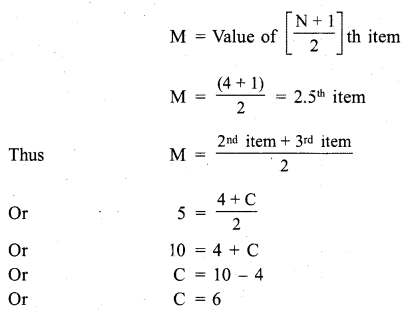
Question 2.
In order of find the median in a discrete series, (N + l)/2 is used, while in continuous series, (N/2) is used, Why?
Answer:
In continuous series the median is of N/2th item’s value not a value of \(\left[ \frac { N+1 }{ 2 } \right] \) th item. Because the value of median have to be similar in ascending and descending order. If we considered is N/2 located on centre point than the value of median would comes out similar and it is suitable to determine the median by cumulative frequency curve because the centre point of the curve is located on N/2.
Question 3.
If the arithmetic mean is 75 and mode is 60, find the value of median.
Answer:
Z = 3M – 2\(\overline { X }\)
60 = 3M – 2 x 75
60 = 3M – 150
3M = 60 + 150
3M = 210
M =210/3
M = 70
Question 4.
Mention any four advantages of median.
Answer:
Following are the four advantages of median :
- It is easy to calculate.
- It is less affected by extreme values.
- Since it is one of the values of the series itself it is a real value.
- They can be calculated by graphical method.
![]()
Question 5.
Write the formula for finding the first quadrant(Q1) and third quadrant (Q3) in a continuous series.
Answer:
Formula
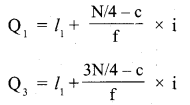
Here i = Class magnitude, f = frequency of class, N = Total frequency, C = cumulative frequency of class preceeding median class, l1 = lower limit of median class.
RBSE Class 11 Economics Chapter 9 Long Answer Type Questions
Question 1.
Find the mode and median from the following table :
| Class Interval | Frequency |
| 0-10 | 10 |
| 10-20 | 3 |
| 20-30 | 7 |
| 30-40 | 15 |
| 40-50 | 5 |
Answer:
Calculation of Median :
| Class Interval | Frequency | Cumulative Frequency |
| 0-10 | 10 | 10 |
| 10-20 | 3 | 13 c |
| 20-30 | 7 f | 20 |
| 30-40 | 15 | 35 |
| 40-50 | 5 | 40 |
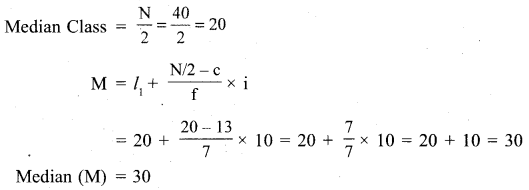
Question 2.
In the following data item series, calculate the first quadrant (Q1), third quadrant (Q3) and median (M) :
| Size | Frequency |
| 11-15 | 7 |
| 16-20 | 10 |
| 21-25 | 13 |
| 26-30 | 26 |
| 31-35 | 35 |
| 36-40 | 22 |
| 41-45 | 11 |
| 46-50 | 5 |
Answer:
| Size | Frequency | cf |
| 11-15 | 7 | 7 |
| 16-20 | 10 | 17 |
| 21-25 | 13 | 30 |
| 26-30 | 26 | 56 |
| 31-35 | 35 | 91 |
| 36-40 | 22 | 113 |
| 41-45 | 11 | 124 |
| 46-50 | 5 | 129 |
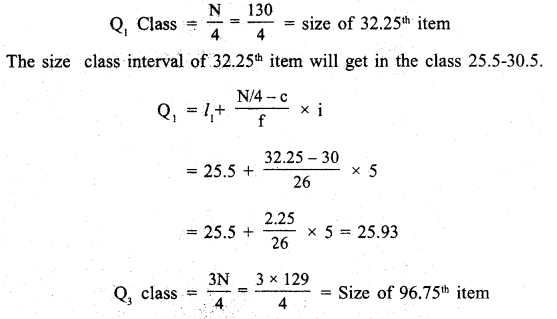
The size class interval of 96.75th item will lie in the class 35.5 – 40.5.
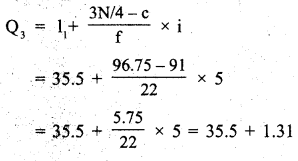

The size class interval of 64.5th item is in the cumulative frequency 91 and it will lie in the class 30.5-35.5.
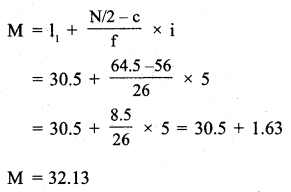
![]()
Question 3.
Give a critical description of the important measures of central tendency and their merits and demerits.
Answer:
The important measures of central tendency are arithmetic mean,median and mode. These are most commonly used in the measures of central tendency.
i. Arithmetic mean :
Arithmetic mean is the most popular and important means among mathematical means, which is generally used by the common man in routine life. The arithmetic mean of a series is the value which is obtained by dividing the sum of all the values of the series by the number of items present in it.
According to W.I.King :
“The arithmetic average may be defined as the sum or aggregate of a series of items divided by their number.”
According to H.Secrist :
“ Arithmetic mean is the amount secured by dividing the sum of values of the items in a series by their number.”
Thus, it is clear that the arithmetic mean is found in the sum of all the values of a general Category, divided by the number of values.
For example, if the monthly income of 5 families is Rs 2000, 3000, 4000, 5000 and Rupees 6000, then for finding out the arithmetic mean or average income of the families, all the incomes of these households are added together, which is Rs. 20000 and then total income will be divided by the total number of items which is 5, The average monthly income will be Rs. 4000, that is the arithmetic mean. Arithmetic mean is of two types :
- Simple Arithmetic Mean
- Weighted Arithmetic Mean
Merits of Arithmetic Mean :
Following are the merits of arithmetic mean-
- Easy to compute and understand :
It is the simplest average to understand and easiest to compute. A layman can also understand it easily. - Based on all items of the series :
It takes into consideration every item in the series in computation. Thus, it is a good representative value. - Definity :
It is defined by a rigid mathematical formula with the result that everyone who computes the average gets the same answer. - Stability :
In comparison to other averages, mean is quite stable. It does not vary too much when repeated samples are taken from one and the same population, at least not as much as some other kinds of statistical descriptions. - Suitable for algebraic treatment :
Being determined by a rigid formula, it lends itself to subsequent algebraic treatment better than the median or mode. - No need for arranging data :
It is not necessary to arrange the values in an array form.
![]()
Following are the demerits of arithmetic mean :
- Effect of extreme value :
Since the value of arithmetic mean depends upon each and every item of the series, therefore, extreme items, i.e. very small and very large items affect the average figure disproportionately. - Unrealistic :
Sometimes it may represent such figure which seems to be unrealistic. - Graphical representation is not possible :
It cannot be calculated by graphical method. - Calculation difficulties :
In comparison to positional averages, calculation of arithmetic mean is more difficult because (i) It cannot be located by mere inspection, while some other averages can be located by mere inspection, (ii) It cannot be determined even if one of the values is not known because it takes into consideration every item in the series in computation, (iii) It is not suitable for qualitative facts. - Fallacious conclusions :
Sometimes it gives fallacious and inconsistent conclusions. - Not suitable in the study of rate, ratio and percentage :
It is not suitable for the study of rate, ratio and percentage.
ii. Mode :
An important measure of the central tendency is ‘mode’. The value which is the most frequently seen in the series, is called ‘mode’. It means that the value having the highest frequency is called ‘mode’. For example, if most men wear ‘7 number shoe’ then the ‘7’ size is ‘mode’.
From the above definitions, it is clear that mode is the value which occurs most often in the series. The mode is expressed by letter Z of the English language.
Properties of Mode :
- Simple and Popular :
This is a simple and popular mean. In some circumstances, it is calculated only by inspection. This mean is very popular in daily life. The average size of the items of daily use such as stitched clothes etc., is located by ‘mode’. - Best Representative :
The value of the ‘mode’ in a series is the one whose recurrence is most often. So this is the best representative of the series. Its value is also taken from the values of the series. - Minimum impact of extreme values :
Another important feature of the mode is that it is not affected by the extreme values of the class. Extreme values have a great effect on arithmetic mean. - Determination by graphical method :
Another advantage of mode is that it can also be determined by graphical method. It can be calculated with the help of a rectangular diagram. - It is possible to find the mode of qualitative facts :
The mode of all those qualitative facts can be found which can be classified and graded. - Unaffected by deviations :
There is no effect of class deviations on mode. - The calculation of all the frequencies is not required :
Only the preceding and succeeding frequencies of the mode item is sufficient.
Demerits of Mode:
Following are the flaws of mode :
- Uncertain and ambiguous :
It is frequently uncertain and ambiguous. It is difficult to determine the value of the mode when each observation occurs the same number of time, also many times, a series has more than one modes. - Lack of algebraic treatment :
It is not suitable for further algebraic treatment. For example, from the modes of two sets of data we cannot calculate the overall mode of the combined data. - Complexity in the computation process :
If mode could be calculated by inspection, it could be simple, else when computed by grouping or interpolation it can be very difficult for laymen. - Illusory mean :
In many situations mode does not represent the series correctly. In such a situation, this mean creates the illusion. - Less importance to extreme values :
It does not give importance to extreme values in the series i.e. it rejects all exceptional instances and is, therefore, not useful in those cases where weights are to be given to extreme values. - The change in class-magnitude also changes the mode :
One drawback of mode is that when class-magnitude changes, its value also changes.
iii. Median :
Median is that variable value of a data-item series which divides the ordered series into two equal parts in such a way that all the values in one part are greater than the median and all the values of the other part are lesser than the median value.
Following are the four advantages of median:
- It is especially useful in case of open-end classes since only the position and not the values of items must be known. The median is also recommended if the distribution has unequal classes, since it is easier to compute than the mean.
- It is not influenced by the magnitude of extreme deviation from it.
- It is the most appropriate average in dealing with qualitative data, i.e. where ranks are given or there are other types of items that are not counted or measured but are scored.
- Perhaps the greatest advantage of median is , however, the fact that the median actually does indicate what many people incorrectly believe the arithmetic mean indicates.
- The median indicates the value of the middle item in the distribution. This is a clear-cut meaning and makes the median a measure that can be easily explained.
Following are the disadvantages of median:
- Lack of Representation :
The median does not represent the average of a group, in which there is considerable difference in the values of different items. - No algebraic treatment :
It is not capable of algebraic treatment. For example, median cannot be used for determining the combined median of two or more groups as it is possible, in case of mean. - Sorting class problem :
To find the median, it is necessary to arrange the data class in ascending or descending order. This work takes time. - Unrealistic :
When the median is somewhere between two values, then this is only a possible value, not real. - Equal significance of all positions :
In its calculation all the positions are given equal importance, which is faulty. - Ignores marginal values :
Marginal values have no effect an median. If some values are of greater importance or weight, then the use of median is inappropriate.
![]()
RBSE Class 11 Economics Chapter 9 Other Important Questions
RBSE Class 11 Economics Chapter 9 Objective Type Questions
Question 1.
Which one is the appropriate measurement for qualitative measurement-
(a) Arithmetic mean
(b) Median
(c) Mode
(d) Geometric Mean
Answer:
(b) Median
Question 2.
The median value of the following item-value is
(a) 16
(b) 24
(c) 15
(d) 13
Answer:
(a) 16
Question 3.
In how many parts does the median divide the data series?
(a) 2
(b) 4
(c) 10
(d) None of these
Answer:
(a) 2
Question 4.
In how many parts does the quartile divide the data series?
(a) 2
(b) 4
(c) 10
(d) 100
Answer:
(b) 4
Question 5.
Which one of the following is a place-related mean?
(a) Median
(b) Arithmetic Men
(c) Geometric Mean
(d) Harmonic Mean
Answer:
(a) Median
![]()
Question 6.
Median in continuous series is
(a) Value of \(\left[ \frac { N+1 }{ 2 } \right] \) th item
(b) Value of \(\left[ \frac { N}{ 2 } \right] \) th item
(c) \(\left[ \frac { N }{ 4 } \right] \) th item’s value
(d) None of these
Answer:
(b) Value of \(\left[ \frac { N+2 }{ 2 } \right] \) th item
Question 7.
Low quartile (Q1) in continuous series is
(a) Value of \(\left[ \frac { N+1 }{ 4 } \right] \) th item
(b) Value of \(\left[ \frac { N }{ 4 } \right] \) th item
(c) \(\left[ \frac { N}{ 2 } \right] \) th item’s Value
(d) None of these
Answer:
(b) Value of \(\left[ \frac { N }{ 4 } \right] \) th item
Question 8.
Which one of these is a measure of central tendency?
(a) Median
(b) Mean Deviation
(c) Standard Deviation
(d) Correlation
Answer:
(a) Median
RBSE Class 11 Economics Chapter 9 Very Short Answer Type Questions
Question 1.
What is meant by median?
Answer:
Median is that variable value of a data-item series which divides the ordered series into two equal parts in such a way that all the values in one part are greater than the median and all the value of the other part are lesser the median value.
Question 2.
What is ascending order?
Answer:
When the item-values are written in order of 1, 2, 3, 4 etc. from small to large, then it is called ascending order.
Question 3.
What is descending order?
Answer:
When the item-values are written in order of 4,3,2,1 etc. from large to small, then it is called descending order.
Question 4.
Write down the formula of median in individual series.
Answer:
M = Value of \(\left[ \frac { N+1 }{ 2 } \right] \) th item
![]()
Question 5.
Write any one property of median.
Answer:
It is the clear and completely defined mean.
Question 6.
Write any one flaw of median.
Answer:
The extreme values are ignored in it.
Question 7.
What kind of ‘quartile’ is Q1?
Answer:
Q1 is low quartile.
Question 8.
What is Q2 called?
Answer:
It is called second quartile or median.
Question 9.
What do you call the 4 equal parts of a series?
Answer:
Quartiles.
Question 10.
In the analysis of social problems, which means is used?
Answer:
Median
Question 11.
Write the formula of median in continuous series.
Answer:
M = L + N1Cf/f × i
Question 12.
Write 3, 1,7, 5, 4, 2, 8 in ascending order.
Answer:
1, 2, 3, 4, 5, 7, 8 .
![]()
Question 13.
What type of mean is used where the values are not to be weighted?
Answer:
Median is used where the values have are not to be weighted.
RBSE Class 11 Economics Chapter 9 Short Answer Type Questions
Question 1.
State the four flaws of median.
Answer:
Following are the four flaws of median.
- The median does not represent the average of a group, in which there is considerable difference in the values of different items.
- It is not capable of algebraic treatment. For example, median cannot be used for determining the combined median of two or more groups, as is possible in case of mean.
- When the median is somewhere between two values, then this is only possible value, not real.
- To find the median, it is necessary to arrange the data class in ascending or descending order. This work takes time.
Question 2.
Explain the uses of median.
Answer:
Owing to the fact that calculation process of median is simple and easy, it is very useful from a practical viewpoint. Median is used for distribution of wealth and property. Median has great utility in analysis of social problems. Median is extremely useful in measurement of attribute aspects, i.e., health, poverty, intelligence, etc. The use of median is suitable where values do not have to be weighted. The dividing values(especially quadrants) are widely used in measuring divergence and skew.
Question 3.
What do you mean by partition value?
Answer:
Partition Values :
Median divides a data item series into two equal series. A series can be divided into four, five, eight, ten and hundred equal parts, using the principle of median. Therefore, the values which divide the series into multiple parts are called partition value. Partition values divide the series into the median, quadrant, pentant, octant, decatant and centatant, respectively, or 2, 4, 5, 8, 10 and 100 parts respectively.
RBSE Class 11 Economics Chapter 9 Long Answer Type Questions
Question 1.
How is median determined in individual series? Clarify it with examples.
Answer:
Determination of median in individual series- In order to determine the median from individual values, firstly, all the values are arranged in ascending or descending order. Then the median value is determined by using the formula given below :
M = Value of \(\left[ \frac { N+1 }{ 2 } \right] \) th item here N = Number of items, M = Median
![]()
Example 1.
Find out the median value of the following data – 50,42,48,52,47,58,60,40,51
Solution:
Firstly arranging the series in ascending order-
| Serial No. | Item-Values |
| 1 | 40 |
| 2 | 42 |
| 3 | 47 |
| 4 | 48 |
| 5 | 50 |
| 6 | 51 |
| 7 | 52 |
| 8 | 58 |
| 9 | 60 |
M = Value of \(\left[ \frac { N+1 }{ 2 } \right] \) th item here N = Number of items, M = Median
Value of \(\left[ \frac { 9+1 }{ 2 } \right] \) th item = Value of 5th item = 50
If the value of item is even, the process will be changed which will clear by the given below example
Example 2.
Given below is the ‘monthly income’ of 10 families. Find the median.

Solution:
Firstly arrange the series in ascending order.
| Serial No. | Monthly Income ( In f) |
| 1 | 800 |
| 2 | 1100 |
| 3 | 1500 |
| 4 | 1700 |
| 5 | 1800 |
| 6 | 2000 |
| 7 | 2200 |
| 8 | 3100 |
| 9 | 3600 |
| 10 | 4000 |
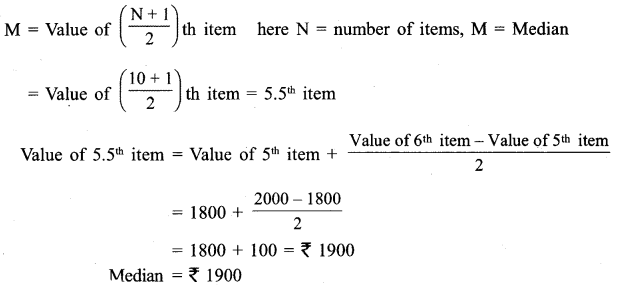
![]()
Question 2.
How is the median calculated in discrete series? Explain it with an example.
Answer:
Calculation of median in discrete series :
Determination of median in discrete series
- Cumulative frequencies are determined as the first step.
- Now, the median’s serial number is found using the following formula :
M = Value of \(\left[ \frac { N+1 }{ 2 } \right] \) th item Where N = Σf
Example:
Find out the median value of the following discrete series-
| Item-Value | 2 | 4 | 6 | 8 | 10 | 12 | 14 |
| Frequency | 5 | 7 | 12 | 18 | 11 | 6 | 4 |
Solution:
| Item-Value | Frequency | Cumulative Frequency |
| 2 | 5 | 5 |
| 4 | 7 | 12 |
| 6 | 12 | 24 |
| 8 | 18 | 42 |
| 10 | 11 | 53 |
| 12 | 6 | 59 |
| 14 | 4 | 63 |
M = Value of \(\left[ \frac { N+1 }{ 2 } \right] \) th item
= Value of \(\left[ \frac { 63+1 }{ 2 } \right] \) th item = value of 32th item
Item 32th is included in the cumulative frequency 42. The value under cumulative frequency 42 is 8.
Hence, Median = 8
Question 3.
Explain the process of determining median in continuous series with example.
Answer:
Following are the process of determining median in continuous series:
i. Cumulative frequencies are determined in the first step.
ii. The median is calculated using the following formula :
M.No = Value of \(\left[ \frac { N }{ 2 } \right] \) th term
iii. When the median serial number is included in a cumulative frequency for the first time, the class related to that cumulative frequency is called the median class.
iv. To determine the median value from median class, the following formula is used:
- When data-item series is ascending order:

- When data-item series is in descending order:

M = Median
i = class magnitude of median class (l2-l1)
f = frequency of median class
N = Total frequencies
c = Cumulative frequency of class preceeding median class
l2 = Upper limit of median class
l1 = Lower limit of median class
Example 1.
Find out the median from the following item series

Solution:
| Obtained Marks | No. of Students (f) | Cumulative Frequency (f) |
| 0-10 | 4 | 4 |
| 10-20 | 6 | 10 cf |
| L1 20-30 | 9 f | 19 |
| 30-40 | 7 | 26 |
| 40-50 | 5 | 31 |
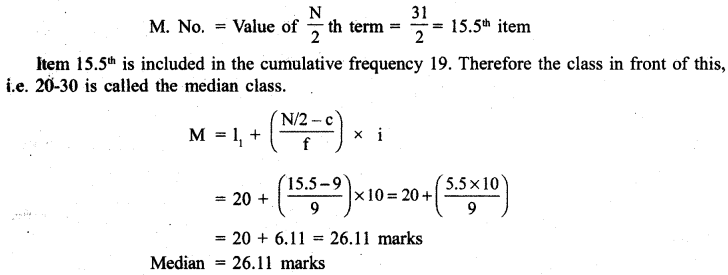
When the class is given in descending order, it can be sorted in ascending order by the above method. If the problem is to be resolved in descending order, then use the following formula
M = l2 – \(\frac { N/2-c }{ f } \)
![]()
Example 2.
Find out the median of the following series

Solution:
| Wages (In ₹) | No. of Workers (f) | Cumulative frequencies (cf) |
| 40-50 | 20 | 20 |
| 30-40 | 35 | 55 cf |
| L2 20-30 | 46 f | 101 |
| 10-20 | 38 | 139 |
| 0-10 | 22 | 161 |
M.No = Value of \( \frac { N }{ 2 } \) th term = \( \frac { 161 }{ 2 } \) = 80.5th term
Item 80.5th is included in the cumulative frequency 101. Therefore the class in front of this is called the median class and the class is (20-30)
M = l2 – \( \frac { N/2-c }{ f } \times i \)
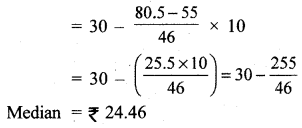
This question can be solved with the help of previous formula by keeping the series in ascending order :
| Wages (In ₹) | No. of Workers (f) | Cumulative frequencies (cf) |
| 0-10 | 22 | 22 |
| 10-20 | 38 | 60 f |
| L1 20-30 | 46 f | 106 |
| 30-40 | 35 | 141 |
| 40-50 | 20 | 161 |
M = value of \( \frac { N }{ 2 } \) th term = \( \frac { 161 }{ 2 } \) = 80.5th term
Item 80.5th is included in the cumulative frequency 106. Therefore the class in front of this is called the median class and the class is (20 – 30). Thus,
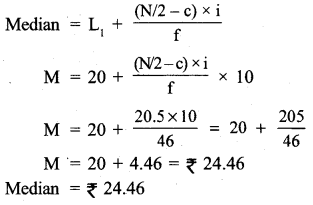
Determination of Median in inclusive series :
If the series is inclusive then to determine the median, first, the series will be changed to an exclusive series. After this, the median is calculated according to the above method.
![]()
Example 3.
Find out the median from the following :

Solution:
| Obtained Marks | No, of Students (f) | Cumulative frequency (cf) |
| 0.5-5.5 | 5 | 5 |
| 5.5-10.5 | 7 | 12 cf |
| L1 10.5-15.5 | 8 f | 20 |
| 15.5-20.5 | 6 | 26 |
| 20.5-25.5 | 4 | 30 |
| 25.5-30.5 | 2 | 32 |
M No. = value of \( \frac { N }{ 2 } \) th term = \( \frac { 32 }{ 2 } \) = 16th term
Item 16th is included in the cumulative frequency 20. Therefore the class in front of this is called the median class and the class is (10.5 – 15.5)
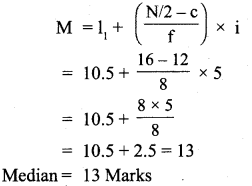
If mid values are given in the question, class – intervals are determined first.
Example 4.
Find out the median from the following data
| Mid-Value | 10 | 20 | 30 | 40 | 50 | 60 |
| Frequency | 5 | 8 | 7 | 6 | 4 | 5 |
Solution:
| Class-Interval (C.I.) | Frequency (f) | Cumulative Frequency (cf) |
| 5-15 | 5 | 5 |
| 15-25 | 8 | 13 cf |
| L1 25-35 | 7 f | 20 |
| 35-45 | 6 | 26 |
| 45-55 | 4 | 30 |
| 55-65 | 5 | 35 |
M No. = value of \( \frac { N }{ 2 } \) th term = \( \frac { 35 }{ 2 } \) = 17.5th term
Item 17.5th is included in the cumulative frequency 20. Therefore the class in front of this is called the median class and the class is (25-35)
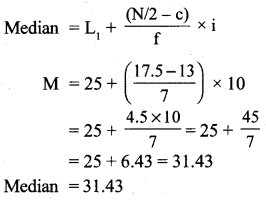
![]()
Question 4.
How is the median determined in cumulative frequency? Explain with examples.
Answer:
The given cumulative frequency should be changed into simple frequency. Thereafter, the median should be calculated
Example 1.
Find out the median from the following series :
| Rate of Wages (Less Than) | 10 | 20 | 30 | 40 | 50 | 60 | 70 | 80 |
| No. of Workers | 15 | 35 | 60 | 84 | 96 | 127 | 198 | 250 |
Solution:
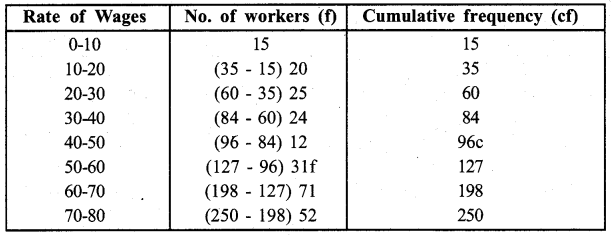
M No. = value of \( \frac { N }{ 2 } \) th term = \( \frac { 250}{ 2 } \) = 125th term
Item 125th is included in the cumulative frequency 127. Therefore the class in front of this is called the median class and the class is (50 – 60)
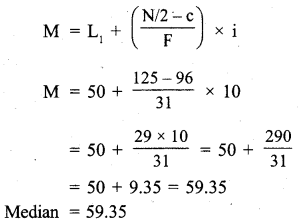
Example 2.
In the following table, 65 students received marks in some examination. Calculate Median
| Obtained Marks (More Than) | 70 | 60 | 50 | 40 | 30 | 20 |
| No. of Students | 7 | 18 | 40 | 40 | 63 | 65 |
Solution:
| Rate of wages | No. of Workers (f) | Cumulative frequency (cf) |
| 20-30 | 2 (65-63) | 2 |
| 30-40 | 23 (63-40) | 25 |
| 40-50 | 00 (40-40) | 25 c |
| L1 50-60 | 22 f (40-18) | 47 |
| 60-70 | 11(18-7) | 58 |
| 70-80 | 7 | 65 |
M No. = value of \( \frac { N }{ 2 } \) th term = \( \frac { 65}{ 2 } \) = 32.5th term
Item 32.5th is included in the cumulative frequency 47. Therefore the class in front of this is called the median class and the class is (50-60)
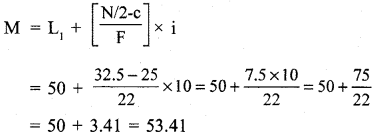
Median = 53.41 Marks
![]()
Question 5.
How is the median determined in unequal distribution? Explain with examples.
Answer:
For determining the median, it is not necessary to have class-intervals of the same size, if the class-interval is not of the same size, then to get the median, they should be made of the same size as far as possible. If this is not possible, then the median should be calculated on the basis of unequal class-intervals.
Example 1.
Find out the median from the following table :

Solution:
| Age | No. of Boys (f) | Cumulative Frequency (cf) |
| 0-2 | 2 | 2 |
| 2-4 | 4 | 6 |
| 4-6 | 4 | 10 |
| 6-8 | 7 | 17 |
| 8-10 | 5 | 22 |
M No. = value of \( \frac { N }{ 2 } \) th term = \( \frac { 22}{ 2 } \) = 11th term
Item 11th is included in the cumulative frequency 17. Therefore the class in front of this is called the median class, and the class is (6-8)

Median = 6.29 years
Example 2.
Find out the median of following series :

Solution:
| Class- Interval | Frequency (f) | Cumulative frequencies (cf) |
| 0-5 | 12 | 12 |
| 5-10 | 15 | 27 |
| 10-20 | 25 | 52 c |
| L1 20-30 | 40 f | 92 |
| 30-40 | 42 | 134 |
| 40-50 | 14 | 148 |
| 50-60 | 8 | 156 |
M No. = value of \( \frac { N }{ 2 } \) th term = \( \frac { 156}{ 2 } \) = 78th term
Item 78th is included in the cumulative frequency 92. Therefore the class in front of this is called the median class and the class is (20-30)
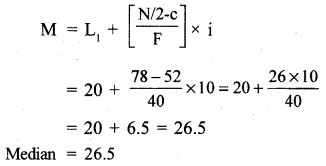
![]()
Question 6.
What do you mean by quartile? How is quartile calculated? Explain with examples.
Answer:
Meaning of Quartile :
The quartile is defined by a measure that divides the series into 4 equal parts. When any item group or series is divided into 4 equal parts, then the last unit of each part is called quartile. Thus there are four quartiles in any series. The fourth quartile price has a final limit so it is not necessary to calculate it, the second quartile is the median, so only the first and third quartiles need to be computed.
The first quartile is called the low quartile and the third quartile is high quartile. These are indicated by symbols Q1 and Q3 respectively. In the first quartile, 25% of the distribution items are less than this and 75% values are more than this. In the second quartile or median, 50% of values are above, and 50% below it, 75% of the items in the third quartile are below it and 25% of the items are above it. Thus, 50% of the figures exist between the boundaries of Q1 and Q3
Method of calculation of Quartiles :
Quartile values for different statistical series are calculated differently
(i) Individual and Discrete Series :
Following formula are used to calculate quartiles in individual and discrete series
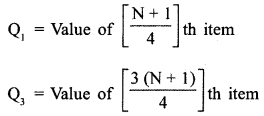
In individual series N = Total no. of items and In discrete series N = Total of Frequencies
(ii) Uninterrupted and Continuous Series :
Q1 and Q3 will be first detected in these series and for this the following formula will be used:
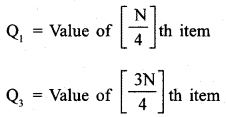
After this, we see the obtained item extracted by the above formula lies in which of the cumulative frequency. The class in front of that cumulative frequency are Q1 and Q3. Then the value of Q1 and Q3 is determined with the help of the formula.
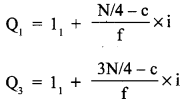
Examples :
(i) Calculation in individual series :
Firstly the values are arranged in order.
Example 1.
Calculate low quartile and high quartile from the following :

Solution:
| Serial No. | Production ( In Tons ) |
| 1 | 10 |
| 2 | 12 |
| 3 | 13 |
| 4 | 14 |
| 5 | 15 |
| 6 | 17 |
| 7 | 18 |
| 8 | 20 |

Value of 2.75th item = Value of second item + 0.25 (value of third item – value of second item)
= 12 + 0.25 (13 – 12)
= 12 + 0.25 x 1
= 12.25
Q1 = 12.25 tonnes

Value of 6.75th item = Value of sixth item + 0.75 (value of seventh item – value of sixth item)
= 17 + 0.75 (18 – 17)
= 17 + 0.75 x l = 17.75 Ton
Q3 = 17.75 Tonnes
(ii) Calculation in Discrete Series :
For the calculation in this series, first see whether the value is sorted or not. If they are not ordered, then they are arranged in ascending or descending order. After this, the cumulative frequency is determined.
![]()
Example 2.
Calculate first and third quartile from the following :

Solution:
| Rate of wages | No. of Workers (f) | Cumulative frequency (cf) |
| 6 | 3 | 3 |
| 7 | 5 | 8 |
| 8 | 9 | 17 |
| 9 | 6 | 23 |
| 10 | 4 | 27 |
| 11 | 7 | 34 |
| 12 | 10 | 44 |
| 13 | 5 | 49 |
| 14 | 4 | 53 |
| 15 | 6 | 59 |

The item 15th is included in the cumulative frequency 17, Therefore the corresponding value 8 is Q1.
Q1 = 8

The item 45th is included in the cumulative frequency 49, Therefore the corresponding value 13 is Q3
Q3 = 13
(iii) Calculation of quartile in continuous series
Example 3.
Calculate first and third quartile from the following frequency distribution :

Solution:
| Value (C.I) | Frequency (f) | Cumulative Frequency (cf) |
| 4-8 | 6 | 6 |
| 8-12 | 10 | 16 |
| 12-16 | 18 | 34 |
| 16-20 | 30 | 64 |
| 20-24 | 15 | 79 |
| 24-28. | 12 | 91 |
| 28-32 | 10 | 101 |
| 32-36 | 6 | 107 |
| 36-40 | 2 | 109 |

The item 27.25th is included in the cumulative frequency 34, Therefore Q3 Class = 12-16.
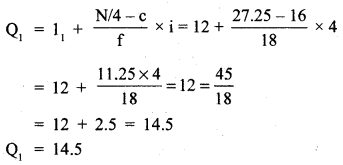
![]()
The item 81.75th is included in the cumulative frequency 91, Therefore Q3 Class = 24 – 28.


![]()
RBSE Class 11 Economics Chapter 9 Numerical Questions
Question 1.
Find out the median value from the following data-
7, 12, 14, 9, 10, 13, 15, 11, 27, 18 , 31
Answer:
Arrange this data in ascending order :
7, 9, 10, 11, 12, 13, 14, 15, 18, 27, 31
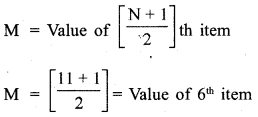
Question 2.
Find out the median from the following data :

Answer:
| Daily Wages (In ₹) | No. of Workers (f) | Cumulative Frequency (cf) |
| 10 | 2 | 2 |
| 11 | 5 | 7 |
| 12 | 6 | 13 |
| 13 | 8 | 21 |
| 14 | 10 | 31 |
| 15 | 12 | 43 |
| 16 | 7 | 50 |
| 17 | 4 | 54 |
| 18 | 1 | 55 |
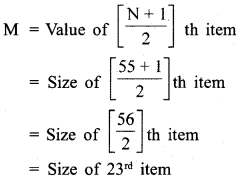
Thus, size of 23rd item is in cumulative frequency 31.
M = 14
Question 3.
Find out median from the following data

Answer:
| Class-interval | Frequency | cf |
| 0-10 | 3 | 3 |
| 10-20 | 5 | 8 c |
| 20-30 | 8 f | 16 |
| 30-40 | 5 | 21 |
| 40-50 | 3 | 24 |
| N = 24 |

The item 12th is included in the cumulative frequency 16, Therefore Median Class = 20 – 30.
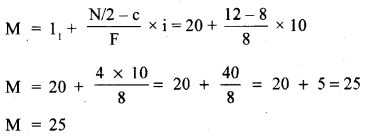
![]()
Question 4.
Calculate Median from the following item series :

Answer:
| Obtained Marks | No. of Students | cf |
| 40-50 | 5 | 5 |
| 30-40 | 7 | 12 c |
| 20-30 | 9 f | 21 |
| 10-20 | 6 | 27 |
| 0-10 | 4 | 31 |
![]()
The item 15.5th is included in the cumulative frequency 21, Therefore Median Class = 20 – 30.

Question 5.
Find out median from the following series :

Answer:
| Class-interval | Frequency | Cumulative Frequency (cf) |
| 0.5-5.5 | 5 | 5 |
| 5.5-10.5 | 7 | 12 c |
| 10.5-15.5 | 8 f | 20 |
| 15.5-20.5 | 6 | 26 |
| 20.5-25.5 | 4 | 30 |
| 25.5-30.5 | 2 | 32 |
| N = 32 |
![]()
The item 16th is included in the cumulative frequency 20, Therefore Median Class = 10.5-15.5.

![]()
Question 6.
Find out median from the following distribution :
| Mid-Value | 10 | 20 | 30 | 40 | 50 |
| Frequency | 5 | 8 | 7 | 6 | 4 |
Answer:
Firstly find out class-interval from the mid-value :
| Mid-Value | Class- interval | f | Cf |
| 10 | 5-15 | 5 | 5 |
| 20 | 15-25 | 8 | 13 c |
| 30 | 25-35 | 7 f | 20 |
| 40 | 35-45 | 6 | 26 |
| 50 | 45-55 | 4 | 30 |
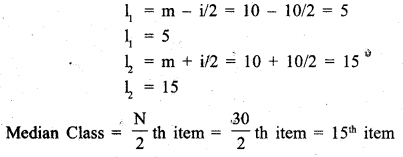
The item 15th is included in the cumulative frequency 20.
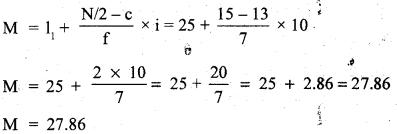
Question 7.
Find out median from the following series :
| Item-Value (Less than) | 10 | 20 | 30 | 40 | 50 | 60 |
| Frequency | 5 | 20 | 70 | 90 | 98 | 100 |
Answer:
| Item value (less than) | Cumulative Frequency cf | f |
| 0-10 | 5 | 5 |
| 10-20 | 20 c | 15 |
| 20-30 | 70 | 50 f |
| 30-40 | 90 | 20 |
| 40-50 | 98 | 8 |
| 50-60 | 100 | 2 |
![]()
The item 50th is included in the cumulative frequency 70, whose class interval is 20 – 30.
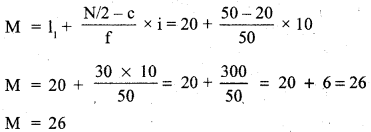
![]()
Question 8.
Calculate median from the following series :
| Income (in ₹) (More Than) | 0 | 10 | 20 | 30 | 40 | 50 | 60 | 70 |
| No. of Families | 100 | 87 | 73 | 60 | 44 | 20 | 10 | 5 |
Answer:
| Income (in ₹) | No. of Families cf | f | cf |
| 0-10 | 100 | 13 | 13 |
| 10-20 | 87 | 14 | 27 |
| 20-30 | 73 | 13 | 40 |
| 30-40 | 60 | 16 | 56 |
| 40-50 | 44 | 24 | 80 |
| 50-60 | 20 | 10 | 90 |
| 60-70 | 10 | 5 | 95 |
| 70-80 | 5 | 5 | 100 |
| N = 100 |
![]()
Seeing the column of cumulative frequency, the class interval is 30-40.
